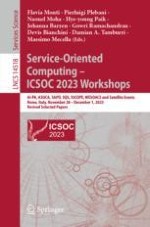This book constitutes revised selected papers from the scientific satellite events held in conjunction with the 21st International Conference on Service-Oriented Computing, ICSOC 2023. The conference was held in Rome, Italy, during November 28 – December 1, 2023.
This year, these satellite events were organized around four main tracks, including a workshop track, a demonstration track, a Ph.D. symposium, and an invited tutorial track.
The ICSOC 2023 workshop track consisted of the following six workshops covering a wide range of topics that fall into the general area of service computing:
Third International Workshop on AI-Enabled Process Automation (AI-PA 2023)
7th Workshop on Adaptive Service-Oriented and Cloud Applications (ASOCA2023)
First International Workshop on Secure, Accountable and Privacy-Preserving Data-Driven Service-Oriented Computing (SAPD 2023)
First Services and Quantum Software Workshop (SQS 2023)
First International Workshop on Sustainable Service-Oriented Computing: Addressing Environmental, Social, and Economic Dimensions (SSCOPE 2023)
19th International Workshop on Engineering Service-Oriented Applications and Cloud Services (WESOACS 2023)
